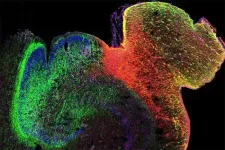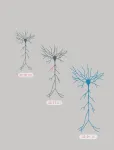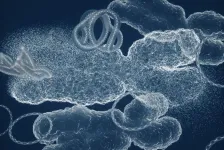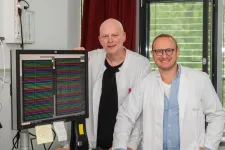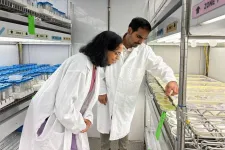(Press-News.org) Each year millions of Pacific salmon make a grand journey from the ocean to their freshwater spawning grounds at the end of their life cycles. This migration has rippling effects through food webs and ecosystems along the way. Whether they decompose or are consumed by other animals, these salmon deliver both nutrients and contaminants they have accumulated in their bodies after spending most of their lives growing at sea. A team of researchers from UConn, the University of South Dakota, the U.S. Geological Survey, Natural Resource Consultants, the University of Saskatchewan, the University of Missouri, and Regis University set out to study the transport of these nutrients and contaminants and trends as the salmon community changed over 40 years. Their findings are published in the journal Nature.
Jess Brandt, assistant professor in UConn’s College of Agriculture, Health and Natural Resources Department of Natural Resources and the Environment and the Center for Environmental Sciences and Engineering, led the project. The study considers the spawning migrations to North America for the five major Pacific salmon species including Chinook, chum, coho, pink, and sockeye salmon. The research team combined estimates of migrating fish biomass for the forty years between 1976 and 2015 with Pacific salmon nutrient and contaminant tissue concentrations from scientific studies and reports.
Energy and nutrients that travel from one system to another and have positive effects are called ecological subsidies. Contaminants that move alongside nutrients that can have detrimental impacts are referred to as ‘the dark side of subsidies,’ says Brandt,
“This research is about the ‘bright and dark sides’ of Pacific salmon subsidies. We usually study them separately in the context of transport by animals, but nutrients and contaminants go hand-in-hand.”
To start, the researchers combined the biomass estimates for each species with nutrient and contaminant concentrations to estimate the movements of these materials carried by salmon. Brandt says these movements had not been estimated at the continental scale before, and the magnitudes of materials transported by Pacific salmon were compelling.
“On average, there were an estimated 119 million Pacific salmon returning to North America each year in the 40-year period of the study. This involved the movement of thousands of tonnes of nutrients and kilograms of contaminants. The fluxes of nutrients by Pacific salmon we report are among the largest fluxes that have been estimated so far for large groups of animals that move materials when they emerge, migrate, or die in large numbers.”
The second question they address is how changes in the Pacific salmon community over time have impacted nutrient and contaminant transport.
They found the Pacific salmon community grew substantially over that 40-year period, both in terms of biomass and number of fish. Brandt says the estimated amount of nutrients and contaminants transported in 2015 was 30% higher than in 1976, and the increase in pink salmon biomass during this period accounted for nearly 80% of the increase they observed.
“We were curious about how shifts in the structure of the Pacific salmon community translated to changes in nutrient and contaminant transport over time” says Brandt.
To understand the significance of these questions, it helps to look at some of the aspects of the lives of different Pacific salmon species. Brandt says that where a species feeds on the food chain (called its trophic level), how long it spends in the ocean, and how large it gets, are all important when considering contaminant concentrations. The environmental contaminants included in this study build up in food webs and increase in concentrations from prey to predators, in a process called biomagnification. This means animals higher in the food web accumulate higher concentrations of these contaminants.
Brandt notes that contaminant concentrations in Pacific salmon are low, overall, relative to many other types of fish. Even still, there are clear differences in contaminant levels among the Pacific salmon species. Pink salmon feed lower on the food web, spend less time at sea, and are small when they return to spawning grounds. By comparison, Chinook salmon feed higher up, spend many years in the ocean, and are the largest of the Pacific salmon species. These differences influence the amounts of contaminants each species transports.
“That's where we started thinking about the loading potential of each species – in other words, how much of each chemical a fish carries - and how loadings of nutrients and contaminants compare. We found the higher trophic level fish, specifically Chinook salmon, will carry relatively high ratios of contaminants to nutrients. On the other hand, pink salmon carry more nutrients per contaminant.”
Despite these differences, pink salmon transported the largest overall amounts of contaminants, and this comes down to sheer numbers, says Brandt,
“We also asked which species were contributing the most to nutrient and contaminant transport by the Pacific salmon community. Even though pink salmon have the lowest tissue concentrations of contaminants, the entire group of pink salmon contributes the greatest share of contaminants transported to North America because they dominate the community. Their numbers have increased, and even if the concentration of the contaminant hasn't changed, if more fish are carrying the contaminant, then there's more contaminant transferred.”
Finally, the researchers considered the tradeoffs in nutrient and contaminant co-exposure for animals that eat salmon, including people. They compared the benefits of the omega-3 fatty acids people get from eating salmon with the health risks associated with the contaminants included in the study. “The results for each species indicated that salmon consumption brings a net benefit to people,” says Brandt. “We believe this means that there is a net benefit to the ecosystem as well”.
Studying nutrients and contaminants together gives powerful insight into the environmental impacts of migratory species like salmon.
“We miss part of the story when we study nutrients and contaminants separately. We hope this study leads to future work focused on migratory species as transporters of nutrients and contaminants and the tradeoffs between the two types of inputs for recipient systems at large spatial scales.”
END
The bright and dark sides of Pacific salmon biotransport
2024-10-09
ELSE PRESS RELEASES FROM THIS DATE:
New therapeutic strategy identified for triple negative breast cancer
2024-10-09
Triple negative breast cancer (TNBC) remains the most aggressive and deadly type of breast cancer, but new findings from cancer researchers at Brigham and Women’s Hospital, a founding member of the Mass General Brigham healthcare system, are pointing the way toward therapeutic strategies that could be tested in clinical trials in the future. Using patient-derived samples in pre-clinical work, researchers discovered that by combining two therapeutic agents they could nudge TNBC cells into a more treatable state. Findings are published in Nature.
“When combined, these therapeutic agents ...
Scientists create first map of DNA modification in the developing human brain
2024-10-09
A UCLA-led study has provided an unprecedented look at how gene regulation evolves during human brain development, showing how the 3D structure of chromatin — DNA and proteins — plays a critical role. This work offers new insights into how early brain development shapes lifelong mental health.
The study, published in Nature, was led by Dr. Chongyuan Luo at UCLA and Dr. Mercedes Paredes at UC San Francisco, in collaboration with researchers from the Salk Institute, UC San Diego and Seoul National University. It created the first map of DNA modification in the hippocampus and prefrontal cortex — two regions ...
Extended Timing: How neurons encode information on timescales that match learning
2024-10-09
New research from the Max Planck Florida Institute for Neuroscience published this week in Nature has identified a key step in how neurons encode information on timescales that match learning.
A timing mismatch
Learning takes seconds to minutes. However, the best-understood mechanisms of how the brain encodes information happen at speeds closer to neural activity—around 1000 times faster. These mechanisms, known as Hebbian plasticity, suggest that if two connected neurons are both active within a hundredth of a second, then the connection between the two neurons is strengthened. In this ...
Dual immunotherapy plus chemotherapy benefits specific subset of patients with lung cancer
2024-10-09
HOUSTON ―Researchers from The University of Texas MD Anderson Cancer Center have demonstrated that patients with metastatic non-squamous non-small cell lung cancer (NSCLC) harboring specific mutations in the STK11 and/or KEAP1 tumor suppressor genes were more likely to benefit from adding the immunotherapy tremelimumab to a combination of durvalumab plus chemotherapy to overcome treatment resistance typically seen in this patient population.
Study results, published today in Nature, identify ...
Scientists discover viral trapdoor blocking HIV and herpes
2024-10-09
Scientists discover viral trapdoor blocking HIV and herpes
Ghent, 10 October 2024 – A group of researchers led by Xavier Saelens and Sven Eyckerman at the VIB-UGent Center for Medical Biotechnology discovered how a protein linked to the human immune system wards off HIV-1 and herpes simplex virus-1 by assembling structures in the cell that lure in these viruses and then trap them or even take them apart. The research was spearheaded by first author George Moschonas, published in Cell Host and Microbe, and could be used to devise new strategies to combat these viruses.
The innate immune system of the human body can sense and respond to viruses by ...
Study uncovers mutations and DNA structures driving bladder cancer
2024-10-09
How bladder cancer originates and progresses has been illuminated as never before in a study led by researchers at Weill Cornell Medicine and the New York Genome Center. The researchers found that antiviral enzymes that mutate the DNA of normal and cancer cells are key promoters of early bladder cancer development, and that standard chemotherapy is also a potent source of mutations. The researchers also discovered that overactive genes within abnormal circular DNA structures in tumor cells genes drive bladder cancer resistance to therapy. These findings are novel insights into bladder cancer biology and point to new therapeutic strategies for this ...
A matter of taste: Electronic tongue reveals AI inner thoughts
2024-10-09
UNIVERSITY PARK, Pa. — A recently developed electronic tongue is capable of identifying differences in similar liquids, such as milk with varying water content; diverse products, including soda types and coffee blends; signs of spoilage in fruit juices; and instances of food safety concerns. The team, led by researchers at Penn State, also found that results were even more accurate when artificial intelligence (AI) used its own assessment parameters to interpret the data generated by the electronic tongue.
The researchers published their results today (Oct. 9) in Nature.
According to the researchers, ...
Another step towards decoding smell
2024-10-09
We often only realize how important our sense of smell is when it is no longer there: food hardly tastes good, or we no longer react to dangers such as the smell of smoke. Researchers at the University Hospital Bonn (UKB), the University of Bonn and the University of Aachen have investigated the neuronal mechanisms of human odor perception for the first time. Individual nerve cells in the brain recognize odors and react specifically to the smell, the image and the written word of an object, for example a banana. The results of this study close a long-standing knowledge gap between animal and human odor research and have now been published in the renowned ...
Plant Science Research collaboration will explore key mosses critical to storing carbon
2024-10-09
ST. LOUIS, MO, October 9, 2024 - Plant scientists at the Donald Danforth Plant Science Center and the HudsonAlpha Institute for Biotechnology have been awarded a four-year National Science Foundation (NSF) Enabling Discovery through GEnomics (EDGE) grant to advance their understanding of sphagnum moss, a crucial component of peatlands and a vital player in global ecosystems. The collaborative research team will develop genetic and genomic resources to study sphagnum's life cycle, growth, and adaptation to various environmental conditions.
Sphagnum ...
Researchers examine the persistence of invisible plastic pollution
2024-10-09
Plastic pollution – tiny bits of plastic, smaller than a grain of sand – is everywhere, a fact of life that applies even to newborn rodents, according to a Rutgers Health study published in the journal Science of the Total Environment.
Researchers have long understood that micro- and nanoplastic particles (MNPs), which enter the environment through oxidation and natural degradation of consumer products, are easily deposited in the human body through inhalation, absorption and diet.
Experts also understand that these pollutants can cross the placental barrier and deposit ...
